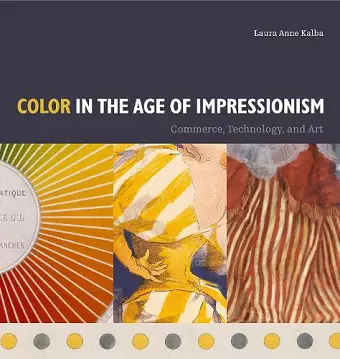Color in the Age of Impressionism
Commerce, Technology, and Art
Format:Hardback
Publisher:Pennsylvania State University Press
Published:21st Apr '17
Currently unavailable, our supplier has not provided us a restock date

This study analyzes the impact of color-making technologies on the visual culture of nineteenth-century France, from the early commercialization of synthetic dyes to the Lumière brothers’ perfection of the autochrome color photography process. Focusing on Impressionist art, Laura Anne Kalba examines the importance of dyes produced in the second half of the nineteenth century to the vision of artists such as Edgar Degas, Pierre-Auguste Renoir, and Claude Monet.
The proliferation of vibrant new colors in France during this time challenged popular understandings of realism, abstraction, and fantasy in the realms of fine art and popular culture. More than simply adding a touch of spectacle to everyday life, Kalba shows, these bright, varied colors came to define the development of a consumer culture increasingly based on the sensual appeal of color. Impressionism—emerging at a time when inexpensively produced color functioned as one of the principal means by and through which people understood modes of visual perception and signification—mirrored and mediated this change, shaping the ways in which people made sense of both modern life and modern art.
Demonstrating the central importance of color history and technologies to the study of visuality, Color in the Age of Impressionism adds a dynamic new layer to our understanding of visual and material culture.
“A truly fascinating read. The ambition and the broad coverage of [this] book will be unsurpassed for a long time when it comes to analyzing the unstoppable march of color into every facet of modern existence.”
—André Dombrowski caa.reviews
“In this beautifully conceived and written book, Kalba shows her depth of vision and understanding of the relationship between Impressionism and the technological advances that allowed Impressionism to have such a unique impact on society in the late 1800s and beyond. The examples are well chosen, and the book is a joy to experience. Summing up: Essential.”
—J. Allison Choice
“Kalba’s book, a valuable resource for scholars of visual culture and French studies, provides a crucial foundation for future explorations of the impact of color on social practices and cultural representations in the nineteenth century.”
—Kristan M. Hanson Nineteenth-Century French Studies
“Laura Kalba brilliantly redefines the relationship between Impressionism and color. Beginning with the proliferation of new chemical dyes, she extends her study to effects of their bright and increasingly variable colors on fashion, horticulture, advertising, interior decoration, and even fireworks. She argues forcefully and convincingly that thanks to industrial and technological developments, the modernity to which the Impressionists were committed became both a democratic and polychromic spectacle—a modern vision that the French often called bariolage.”
—James H. Rubin, author of Impressionism and the Modern Landscape: Productivity, Technology, and Urbanization from Manet to Van Gogh
“A first-rate study of a significant historical shift in the relationships among art, culture, and the technological basis of vision in nineteenth-century France. This book enlarges our understanding of the links that connected nineteenth-century French laboratory science and industry with the popular imagination. It deserves to be read widely.”
—Jennifer Tucker, author of Nature Exposed: Photography as Eyewitness in Victorian Science
“Laura Kalba tells us a bottom-up story about color: a history of the chemical, optical, commercial, and nationalist practice of color. Moving from one key visual phenomenon to another, she shows how inherent qualities of color were understood in the particular time and place she studies. Color, she convinces us, is both a material quality and a condition of visuality. Her method allows Impressionism to become only one among several key color phenomena of late nineteenth-century France. Paradoxically, that is exactly what allows her to make fresh, basic, compelling arguments about Impressionism. The whole book is a game-changer.”
—Anne Higonnet, author of A Museum of One’s Own: Private Collecting, Public Gift
“[This book’s] conclusion—that new technologies, media, and consumer goods made vibrant color a central aspect of modern visual environments—is indisputable and provides a valuable insight into late nineteenth-century French urban life.”
—Patricia Mainardi American Historical Review
“As much a book about the chemistry of thought as it is about the chemistry of Impressionist painting.”
—Michael Rossi Critical Inquiry
“This book is an admirable work of scholarship that makes a very significant, original contribution to our understanding of how color has influenced the way in which people experience the world around them, as well as the ways in which artists have represented that world. It should be required reading not only for specialists in art history and visual culture, but also for any scholar of nineteenth-century French history.”
—Jeanne Morgan Zarucchi H-France
- Nominated for David H. Pinkney Prize 2017
ISBN: 9780271077000
Dimensions: 241mm x 229mm x 27mm
Weight: 1429g
288 pages